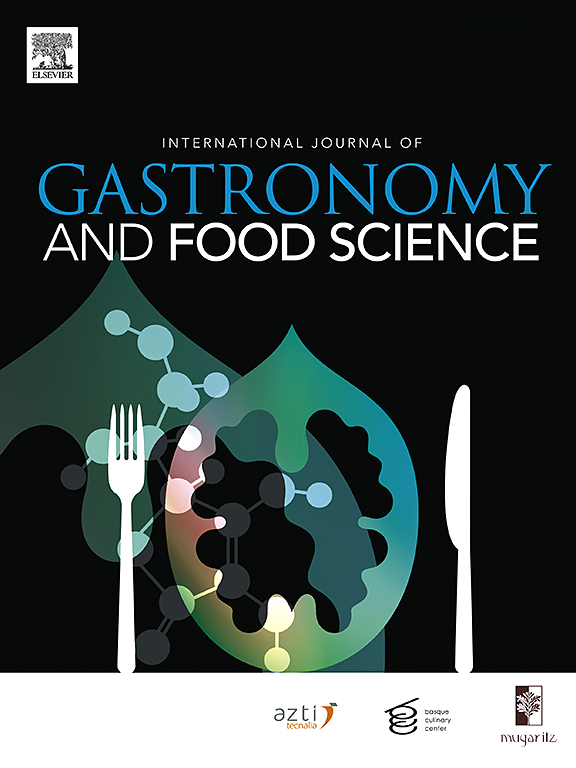The nutritional quality and flavor profiles of Sandiao soup made by the traditional refinement process
IF 3.2
2区 农林科学
Q2 FOOD SCIENCE & TECHNOLOGY
International Journal of Gastronomy and Food Science
Pub Date : 2024-12-12
DOI:10.1016/j.ijgfs.2024.101084
引用次数: 0
Abstract
Sandiao soup is a classic feature of Huaiyang cuisine. This study analyzed the changes in Sandiao soup’s nutritional components and flavor compounds during its production via the traditional refinement process, with a focus on determining the changes in the pH, salinity, color, calorific value, and amino acid and nucleotide composition of the soup during the suspension part of this process. The changes in the main components and flavor compounds of Sandiao soup were analyzed using an electronic tongue and electronic nose and by gas chromatograph–ion mobility spectroscopy (GC-IMS). As the simmering time of the soup increased, its pH decreased, salinity and solid content increased, clarity increased, and brightness decreased, correlating with the highest sensory score. In addition, as the suspension time of the soup increased, its nucleotide content increased (particularly its concentration of inosine monophosphate and guanosine monophosphate, which are significant flavor components in the soup), and the concentration of free amino acids increased, with the concentrations of alanine and glutamic acid being the highest. Principal component analysis revealed that the taste of the soup changed during the suspension process. GC-IMS analysis identified 35 flavor compounds in the soup and showed that aldehydes (particularly nonanal and hexanal), alcohols, ketones, and esters made the greatest contributions to the flavor. The best results in terms of color, flavor, and other organoleptic indicators were achieved when the stock was processed three times. Overall, the results show that Sandiao soup becomes enriched in nutritional components and key flavor compounds as the suspension time during its processing increases.
采用传统精制工艺制作的三调汤的营养品质和风味特征
三调汤是淮扬菜的经典特色。本研究通过传统的精制工艺,分析了三调汤在生产过程中营养成分和风味物质的变化,重点测定了三调汤在悬浮过程中pH值、盐度、颜色、热值、氨基酸和核苷酸组成的变化。采用电子舌、电子鼻和气相色谱-离子迁移谱(GC-IMS)分析了三调汤中主要成分和风味物质的变化。随着炖煮时间的延长,汤的pH值降低,盐度和固体含量增加,透明度增加,亮度降低,与感官得分最高相关。此外,随着汤汁悬浮时间的延长,其核苷酸含量增加(尤其是汤中重要风味成分单磷酸肌苷和单磷酸鸟苷的浓度),游离氨基酸浓度增加,其中丙氨酸和谷氨酸的浓度最高。主成分分析表明,汤的味道在悬浮过程中发生了变化。GC-IMS分析鉴定出汤中35种风味化合物,表明醛类(特别是壬醛和己醛)、醇类、酮类和酯类对风味的贡献最大。在颜色、风味和其他感官指标方面,当原料酒经过三次加工时达到最佳效果。综上所述,随着三调汤在加工过程中悬浮时间的延长,其营养成分和主要风味成分都有所增加。
本文章由计算机程序翻译,如有差异,请以英文原文为准。
求助全文
约1分钟内获得全文
求助全文
来源期刊

International Journal of Gastronomy and Food Science
Social Sciences-Cultural Studies
CiteScore
5.30
自引率
10.50%
发文量
170
审稿时长
45 days
期刊介绍:
International Journal of Gastronomy and Food Science is a peer-reviewed journal that explicitly focuses on the interface of food science and gastronomy. Articles focusing only on food science will not be considered. This journal equally encourages both scientists and chefs to publish original scientific papers, review articles and original culinary works. We seek articles with clear evidence of this interaction. From a scientific perspective, this publication aims to become the home for research from the whole community of food science and gastronomy.
IJGFS explores all aspects related to the growing field of the interaction of gastronomy and food science, in areas such as food chemistry, food technology and culinary techniques, food microbiology, genetics, sensory science, neuroscience, psychology, culinary concepts, culinary trends, and gastronomic experience (all the elements that contribute to the appreciation and enjoyment of the meal. Also relevant is research on science-based educational programs in gastronomy, anthropology, gastronomic history and food sociology. All these areas of knowledge are crucial to gastronomy, as they contribute to a better understanding of this broad term and its practical implications for science and society.
 求助内容:
求助内容: 应助结果提醒方式:
应助结果提醒方式:


